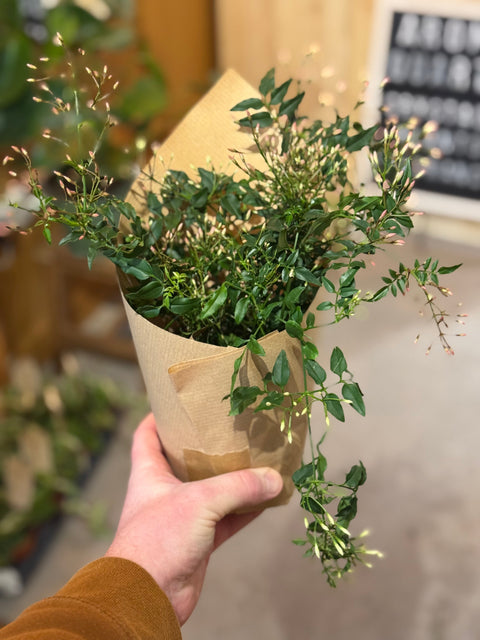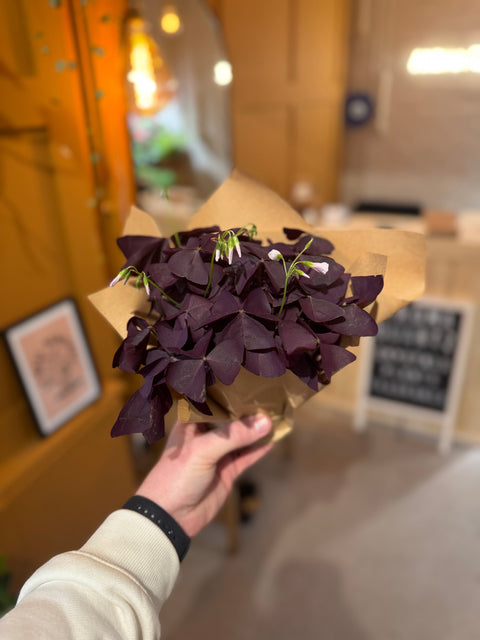Pink Jasmine (Jasminum polyanthum) Care Guide 🌸
The Pink Jasmine, or Jasminum polyanthum, is a fragrant and beautiful climbing vine that will fill your home with sweet floral aromas. Known for its stunning pink and white flowers, this jasmine variety is a popular choice for both indoor and outdoor gardens.
With the right care, your Pink Jasmine will thrive and reward you with a spectacular display of flowers. Here's everything you need to know about keeping this plant healthy and happy.
🌸 Quick Overview
- Botanical Name: Jasminum polyanthum
- Common Name: Pink Jasmine, Chinese Jasmine
- Native To: China and Himalayas
- Light Needs: Bright, indirect light
- Watering: Keep soil moderately moist; avoid soggy conditions
- Pet Safety: Toxic to cats and dogs (keep out of reach)
☀️ Light Requirements
Pink Jasmine requires bright, indirect light to thrive. A location near a south or west-facing window is ideal. If grown indoors, place the plant in a well-lit area but avoid direct sunlight, which can scorch the delicate leaves.
💡 Tip: During the winter months, consider supplementing with a grow light to ensure your jasmine gets enough light to bloom.
💧 Watering
Pink Jasmine prefers moderate watering. Keep the soil consistently moist but not waterlogged. Allow the top 1-2 inches of soil to dry out before watering again. Water thoroughly, ensuring excess water drains from the pot.
- Overwatering: Can lead to root rot. Ensure the pot has drainage holes.
- Underwatering: Leaves may start to wilt and turn yellow.
🪴 Soil & Potting
For best results, plant your Pink Jasmine in a well-draining potting mix. A blend of peat, perlite, and a bit of sand is a great choice. Use a container with drainage holes to prevent water from collecting at the bottom.
💦 Humidity & Temperature
Pink Jasmine prefers moderate to high humidity and warmer temperatures.
- Humidity: 50% or higher is ideal
- Temperature: 18–24°C (65–75°F)
If the air is too dry, consider using a humidity tray, humidifier, or misting the plant regularly to maintain optimal moisture levels.
🌿 Pruning & Maintenance
Pruning your Pink Jasmine will help it maintain its shape and encourage more blooms. Trim back leggy growth and any spent flowers to keep it tidy.
- Prune after blooming to promote healthy growth.
- If it becomes too large, trim it back to control its size and shape.
🌱 Propagation
Pink Jasmine can be propagated through stem cuttings. Here's how:
- Take a 4-6 inch cutting from a healthy stem, making sure it has a node.
- Remove the lower leaves and dip the cutting in rooting hormone.
- Place it in a pot with well-draining soil and keep it moist.
- Rooting usually occurs within 3-4 weeks. Once roots form, transfer it to a larger pot.
🍽️ Feeding
Feed your Pink Jasmine during the growing season (spring and summer) with a balanced, water-soluble fertiliser every 4-6 weeks.
In autumn and winter, you can reduce feeding since the plant enters a resting phase.
🚨 Common Problems
- Yellowing Leaves: Often a sign of overwatering or poor drainage.
- Wilting: Could indicate underwatering or low humidity.
- Leaf Drop: Can occur if the plant is stressed from a sudden change in light or temperature.
- Pests: Check for common pests like aphids or spider mites. Treat with neem oil or insecticidal soap.
🌟 Extra Tips for Success
- If you're growing Pink Jasmine outdoors, place it in a spot where it can climb on a trellis or fence for maximum impact.
- Make sure to check the humidity levels regularly if you’re growing it indoors in drier conditions.
Final Thoughts
With its stunning fragrance and beautiful blooms, Pink Jasmine is a rewarding plant to grow. Whether you're growing it as a vine, in a hanging basket, or on a trellis, proper care will ensure that it thrives and fills your home with delightful scent and beauty.



